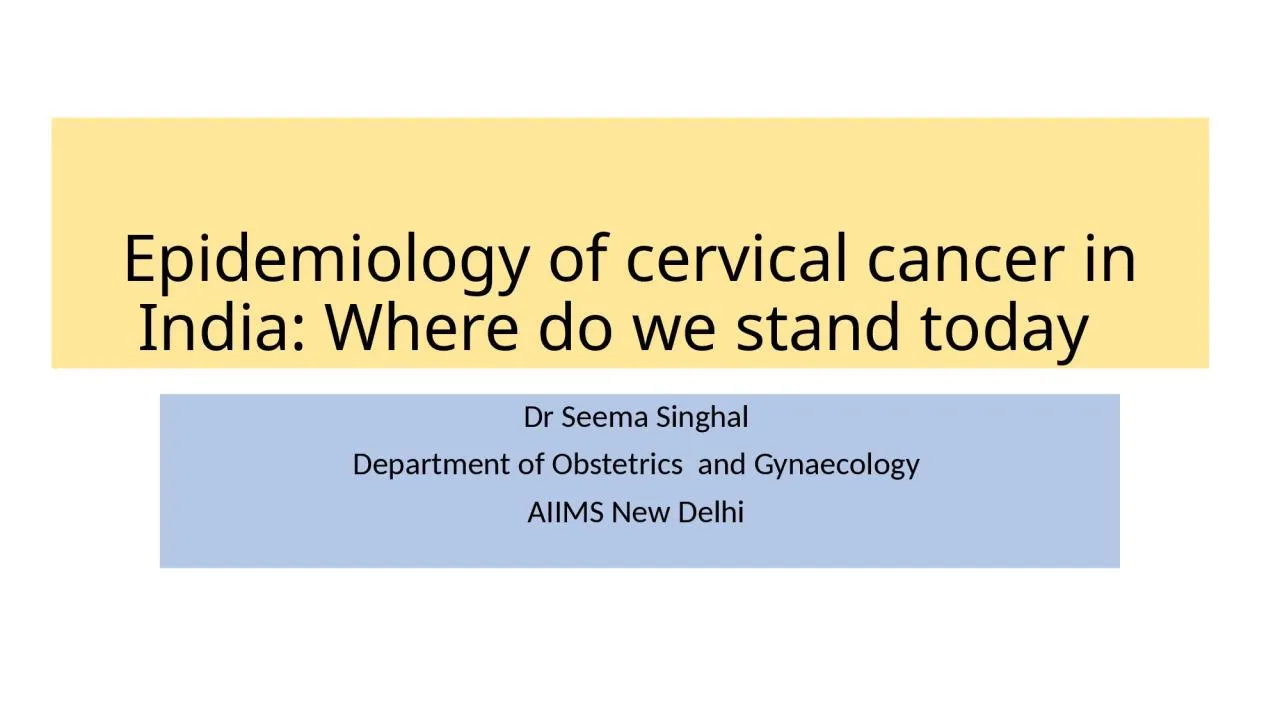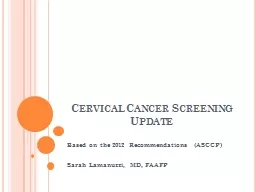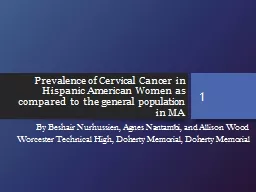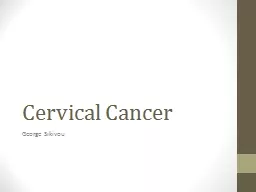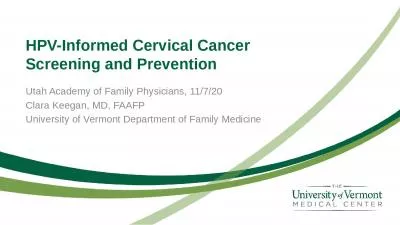PPT-Epidemiology of cervical cancer in India: Where do we stand today
Author : bery | Published Date : 2022-06-07
Dr Seema Singhal Department of Obstetrics and Gynaecology AIIMS New Delhi Cervical cancer disease burden Global Incidence and mortality in 2018 India Major
Presentation Embed Code
Download Presentation
Download Presentation The PPT/PDF document "Epidemiology of cervical cancer in India..." is the property of its rightful owner. Permission is granted to download and print the materials on this website for personal, non-commercial use only, and to display it on your personal computer provided you do not modify the materials and that you retain all copyright notices contained in the materials. By downloading content from our website, you accept the terms of this agreement.
Epidemiology of cervical cancer in India: Where do we stand today: Transcript
Dr Seema Singhal Department of Obstetrics and Gynaecology AIIMS New Delhi Cervical cancer disease burden Global Incidence and mortality in 2018 India Major contributor to global burden of cervical cancer . Arkansas Statistics. Nancy Andrews Collins, M.D., MBA. Associate Professor. Department of Obstetrics and Gynecology. College of Medicine. University of Arkansas for Medical Sciences (UAMS). Ovarian Cancer. George . Sikivou. What Is . I. t?. The cancer of the cervix, which is caused mainly by the Human Papilloma Virus (HPV). 70% of cervical cancers and precancerous cervical lesions are caused by Types 16, 18.. Based on the 2012 Recommendations (ASCCP). Sarah Lamanuzzi, MD, FAAFP. Disclosures. I have no disclosures other than: the ASCCP gave permission for use of their slide content.. The American Society for Colposcopy and Cervical Pathology. “Cervical Cancer Screening Recommendations, . The Obstetrics & Gynecological Society of Bhopal. &. AMPOGS Research Public Welfare Society. BREAST . AND GENITAL TRACT CANCER INCIDENCE RATES PER 100,000 . FEMALES worldwide. 31.3. 17.4. 8.3. Annual CPCRN Meeting, Chicago. Tuesday, May 24. th. . Lead: Karen Glanz, PhD, MPH. Participating Sites: . UPenn. , UNC, . UWash. , CDC, NCI. This presentation was supported by Cooperative Agreement Number U48 DP005053 from the Centers for Disease Control and Prevention. The findings and conclusions in this presentation are those of the author(s) and do not necessarily represent the official position of the Centers for Disease Control and Prevention. . 141. st. APHA Annual Meeting. November 2013. Richard A. Crosby, PhD. University of Kentucky College of Public Health. Department of Health Behavior. . Presenter Disclosures. (1) The following personal financial relationships with commercial interests relevant to this presentation existed during the past 12 months:. Cervical Cancer Statistics. United . States. An estimated 12,000 new cases each year. An estimated 4,000 . deaths . each year . 700,000 cases of severe . pre-cancer . International. Approximately 500,000 cases expected worldwide each year!. By Beshair Nurhussien, Agnes Nantambi, and Allison Wood. Worcester Technical High, Doherty Memorial, Doherty Memorial. 1. Health Disparity. “Difference in the incidence, prevalence mortality, and other adverse health conditions that exist among specific population groups.” . What Is . I. t?. The cancer of the cervix, which is caused mainly by the Human Papilloma Virus (HPV). 70% of cervical cancers and precancerous cervical lesions are caused by Types 16, 18.. Most common type is Squamous Cell Carcinoma (SCC). Megan Swanson, MD MPH. Assistant Professor. Gynecologic Oncology. UCSF. Limited effective treatment options for advanced cervical cancer. Problem. : when cervical cancer is . advanced. and/or recurrent . Objectives . 1. What is cervical cancer?. 2. Who gets cervical cancer?. 3. Can it be prevented?. 4. What treatment is available?. . Quiz time!. Which viral infection is the most common cause of cervical cancer?. Chemoradiation Huma Chaudhry Jordan Kharofa Faculty: Dr. Beth Erickson, MD Medical College of Wisconsin Department of Radiation Oncology July 14, 2013 Clinical Presentation 47 year old G2P2 female Selemawit. Ghebrendrias. 1. , Sarah Pfeil. 1. , Sheila K. Mody. 1. , Bonnie Crouthamel. 1. , Morgen Chalmiers. 1. , . Gennifer. Kully. 1. 1. Division Of Family Planning, Department Of Obstetrics, Gynecology, And Reproductive Sciences, University Of California, San Diego. Utah Academy of Family Physicians, 11/7/20. Clara . Keegan, . MD, FAAFP. University of Vermont Department of Family Medicine. After this activity, I hope you will be able to …. Summarize the natural history of HPV as it relates to cervical cancer screening..
Download Document
Here is the link to download the presentation.
"Epidemiology of cervical cancer in India: Where do we stand today"The content belongs to its owner. You may download and print it for personal use, without modification, and keep all copyright notices. By downloading, you agree to these terms.
Related Documents

